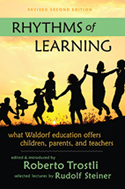
-
RHYTHMS OF LEARNING
(Revised second edition) Introduction by Roberto Trostli
What Waldorf Education Offers Children, Parents, and Teachers
Rudolf Steiner

“The primary task of a Waldorf teacher is to understand the human being in body, soul, and spirit. The approach, the curriculum, and the methods of an education that can address the whole child will grow from this understanding.” —Roberto Trostli
Waldorf education—an established and growing independent school movement—continues to be shaped and inspired by Rudolf Steiner’s numerous writings and lectures on education and child development.
In Rhythms of Learning, key lectures on children and education have been thoughtfully chosen from the vast amount of material by Steiner and presented in a context that makes them reader-friendly and accessible. In his many discussions and lectures, Steiner shared his vision of education that considers the spirit, soul, and physiology in children as they grow.
Roberto Trostli, a seasoned Waldorf teacher, has selected the works that best illustrate the fundamentals of this unique approach. In each chapter, Trostli explains Steiner’s concepts and describes how they work in the contemporary Waldorf classroom. We learn how the teacher–child relationship and the Waldorf school curriculum changes as the students progress from kindergarten through high school.
Rhythms of Learning, is an excellent resource for parents who want to understand how their child is learning. Parents will also be more prepared to discuss their child’s education with teachers, and teachers will find it to be a valuable reference source and communication tool.
“Our new generation of children will need an education that not only addresses their intellects but also cultivates their artistic abilities and develops their practical skills. Above all they will need an education that can nurture the capacities that will allow them to adapt to a rapidly changing world. Emil Molt knew the man who developed a form of education that meets those needs; that man was Rudolf Steiner.” —Roberto Trostli
Contents
Sources Foreword
Preface to the Revised Edition
Introduction: A Seed for the Future
The Foundations of Waldorf Education
The Education of the Child in the Light of Spiritual Science
Teacher and Child
The Four Temperaments
Understanding Children’s Temperaments
Gratitude, Love, and Duty
The Waldorf Kindergarten
The World of the Young Child
Walking, Speaking, Thinking
The First School Years
From Whole to Part
Children from the Seventh to Tenth Years
Teaching Children to Write
Teaching Arithmetic
The Middle Elementary School Years
Self and World
Zoology and Botany in the Elementary School
Nature Study in the Elementary School
Teaching Geography
The Upper Elementary School Years
Cause and Consequence
The Child at Twelve
Teaching in the Upper Grades
Teaching History
The High School Years
Adolescence—the Quest for Self
Working with Adolescents
The Arts in Waldorf Education
The Jewels in the Crown
Education through Art
An Introduction to EurythmyMarch 2017; SB; 366pp; 23 x 15 cm; pb;
£30.00 ISBN 9781621481799

